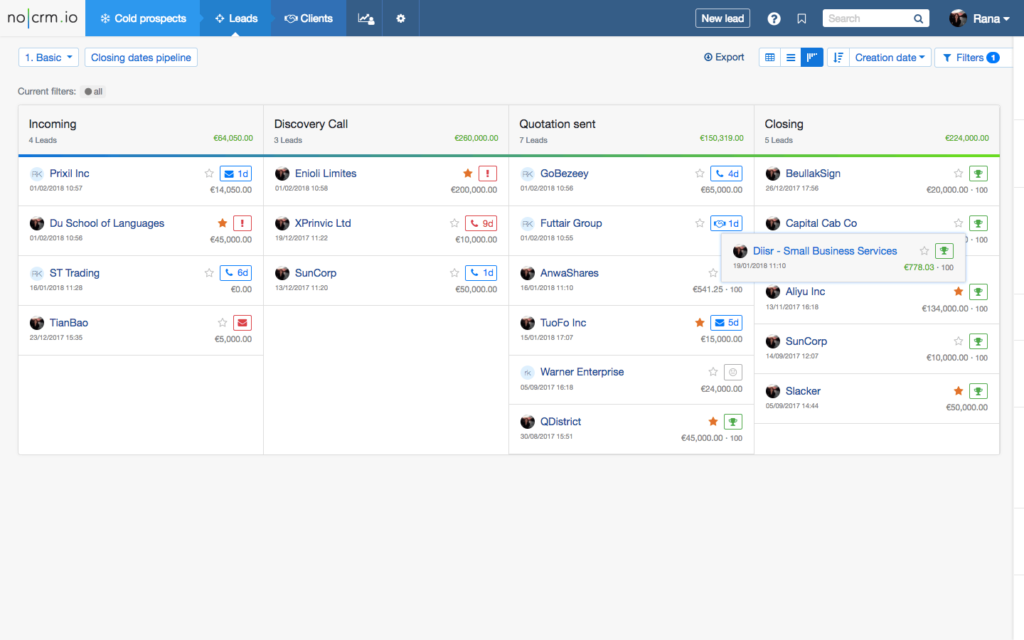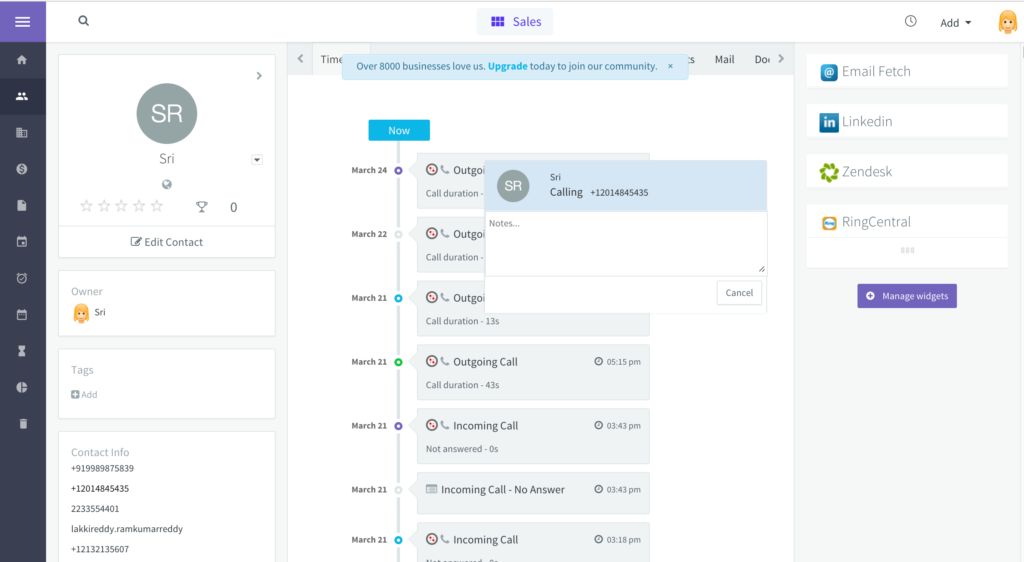If you work in a business—especially a business that sells to other businesses—then you might’ve heard of the term “lead nurturing.”
The more complex your product or service, and the more expensive it is, the more important lead nurturing tends to be. So, in this post, we’re going to show you how to become an expert at lead nurturing. We’ll look at:
- What exactly lead nurturing is and why it’s important
- How to build a lead nurturing strategy in 6 steps
- 4 lead nurturing best practices
First, let’s look at what lead nurturing is.
What is lead nurturing?
Lead nurturing is the process by which a business builds (or “nurtures”) a relationship with a potential customer, with the goal of ultimately making the sale. It takes a long-term view of the sales process, with the understanding that not every potential customer is ready to buy right at this moment.
When you’re nurturing a lead, you’re essentially nurturing that relationship, whether that’s by sharing educational videos with them, or engaging them with a discount or free trial, or even sending them regular updates about new products to build excitement.
The goal? To get the lead to “display” (also referred to as “raising their hand”), which basically means that they’re showing us that they’re ready to talk to someone from Sales.
Why is lead nurturing important?
Lead nurturing is important because not everyone is ready to become a customer right now.
As we mentioned earlier, the more expensive your product or service, (usually) the more time your lead will need to shop around and do research before deciding which luxury SUV, or which fancy cold calling software, or which marketing agency they’re going to choose.
In fact, according to Marketo, about 96% of visitors who come to your website actually aren’t ready to buy yet.1 That’s huge, because that says that the vast majority of people coming to you need to be convinced that you’re the right choice.
So, how do you do that?
How to build a lead nurturing strategy in 6 steps
Step 1. Know what a good lead actually looks like
This is an often-overlooked step. Some businesses might think that the more leads you bring in, the better. Right?
Well, not exactly. To be successful at nurturing leads, you first need high-quality leads who are a good fit for the product or service you’re selling.
Know your ideal customer or user persona. If your best customers are stay-at-home dads who cook but your Instagram ad campaign’s aesthetic appeals more to hip college students, then you’re probably going to have a tough time nurturing the leads or signups you get from the campaign because they were a bad fit to begin with.
Step 2. Have a way to score your leads
Say you’ve successfully gotten a big group of leads who have signed up for your email newsletter from your Instagram ad campaign. These are all people who could potentially become customers—the only thing is, some of them might still be in early stages of the customer journey, while others just need a little extra nudge over the finish line to take out their credit cards.
Learn about customer journey maps and download a template to help you visualize your customers’ journeys.
You’ll probably need to nurture these two groups of leads in different ways, right?
For example, the leads who are close to buying might just need a small discount offer, while the leads who are still in the early stages of the buying process might need more work. Maybe you could send them some YouTube videos that show how easy your product is to use, or maybe you could send them some awesome case studies that show off how successful your past clients were thanks to your consulting services.
This also shows why Step 1 is so important: depending on your company and industry, you’ll score your leads in different ways. For example, here’s how a real estate agent might score their leads:
| 📧 Signed up for email newsletter | +10 points |
| 👀 Opened 80%+ of emails in the last month | +10 points |
| 🖊️ Filled out contact sheet while browsing at an open house | +40 points |
| 👋 Filled out a contact form on website | +50 points |
| ⏳ Gave a buying timeline of “next three months” | +40 points |
| ✅ Indicated that they’ve got a preapproval | +30 points |
It’s important to note that the point of lead scoring is not just to gauge engagement, but also to set a trigger for the lead to be passed to your sales team once they hit the score threshold. For example, once they hit 50 points, you might consider them a “marketing qualified lead” (or MQL), which means they can be passed on to a salesperson. (You don’t want to just send cold leads to Sales!)
Be careful how you score leads for nurturing later—not every single interaction is worthy of a score. For example, some businesses might give leads additional points in their score for liking or commenting on a Facebook post. But does interacting with a social media post really indicate buying intent? That’s your call… (But most of the time, we’d say that’s a solid no.)
Step 3. Use the right lead nurturing software
Depending on how fancy your technology is, you can get super granular with lead nurturing.
For example, some businesses have websites that can track how a lead got to your website (was it from Google’s search results? Or did they enter your URL directly—which would suggest that they’re already familiar with your company?), and even how long someone spends on a particular page.
(If someone spent a long time browsing your case studies pages, that might indicate that they have a high level of interest in your product).
Of course, if we’re talking about lead nurturing software, the most important tool to have is probably a MAP (marketing automation platform).
MAPs are pretty much crucial because they store important information about your leads—and I don’t just mean stuff like addresses and phone numbers. Yes, those are important, but the real juicy data is related to those leads’ buying decisions and relationship with your business so far.
Here are a few examples of things you should know about your leads (and that should be logged in your MAP):
- Have they interacted with you in the past? What web pages have they visited?
- When was the last time they interacted with you? (Over the phone, email, etc.)
- Have they shown interest in specific products?
- Have they visited the pricing page before or asked about pricing?
- Have they disclosed their current provider or competitors they’re also evaluating?
- Based on your outreach, what kind of content have they been most responsive to?
If you can find out this kind of information, it’ll help make your outreach efforts more effective, whether your lead nurturing tactic is a series of automated emails or a regular follow-up phone call.
Let’s say you’re using HubSpot as your lead nurturing software. You can integrate it with your phone service, for example like RingCentral, so that it automatically logs all your phone calls and other conversations, with prospects right in their profile:
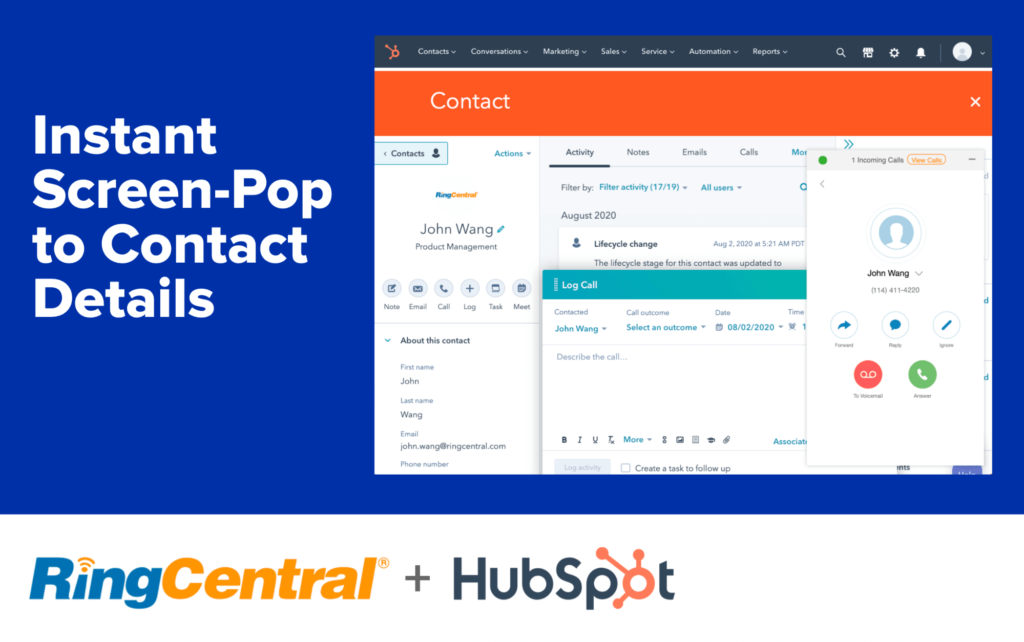
If your business is client-based, or just relies heavily on phone calls to communicate with your leads, then you should really look into a phone service that integrates with MAPs and CRMs like HubSpot and Salesforce.
These integrations often have features that can save you a lot of time, like letting you click-to-dial to make phone calls from right inside the platform:
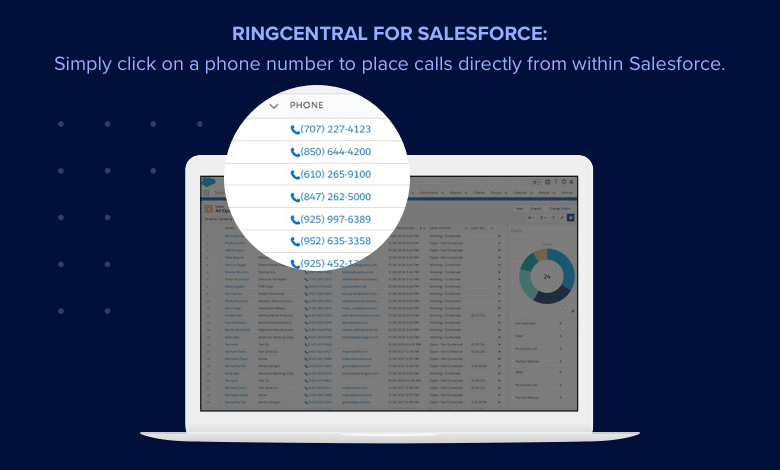
After each call, don’t forget to log the details and any additional notes or follow-ups. Not only does this help you keep all the updates about a specific lead in one place, it also makes it easier for your teammates to pick up on conversations with leads if you’re ever sick or on vacation.
Step 4. Approach lead nurturing as a team
Another major aspect of lead nurturing beyond just communicating with leads is communicating and collaborating effectively within your own team and business.
Most successful examples of lead nurturing are a result of close collaboration between the marketing and sales team. Why? Because both teams could potentially be nurturing leads—the marketing team by creating nurture marketing content like blog posts and videos, and the sales team through phone calls and email communication with the leads themselves.
From choosing a lead scoring system to deciding how to nurture the leads, there are a ton of opportunities for cross-functional team collaboration. How can you make that process easier?
In most cases, all you need is a good communication platform. Beyond just emailing each other, ideally teammates should be able to chat with each other and get answers quickly. That could be through group chats, video conference calls, or even phone calls. Often, it’ll be a mix of all of them. (Let’s face it, an email isn’t the best way to reach out.)
If that sounds like a lot of communication channels—and a lot of windows and apps to manage, well, good news is that’s not always the case. There are tools out there that can consolidate these different communication options. Like the RingCentral app, for instance, which gives you team messaging, video conferencing, and a phone service in one place:
You can even share files…

Do screen sharing…
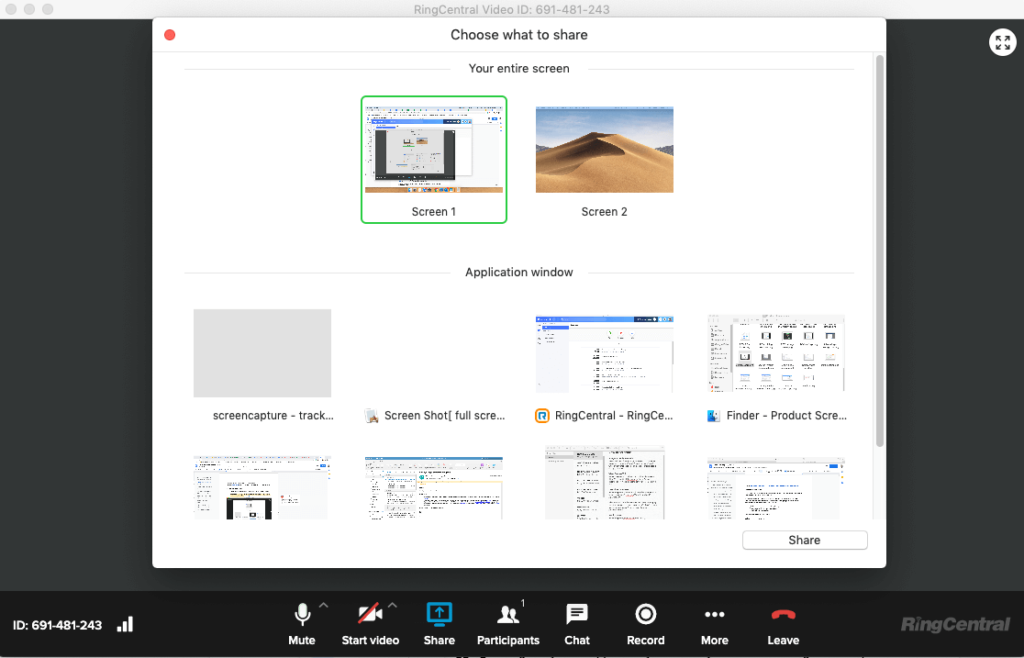
And create and assign tasks to teammates—say, to follow up with a lead:

Step 5. Have your marketing / sales process mapped out
In order to create lead nurturing content that’s successful, you need clear goals for everything you’re creating.
Some content may not have to close the deal—they just need to get the lead interested enough to check out your pricing plans or different product options.
Other content may be meant for a prospect who’s really close to buying; they’re just stuck deciding between you and your biggest competitor.
Want to find more ways to boost your sales performance? Grab this free eBook on building an effective outbound strategy:
For example, in the sales process example below, you might want to create content for the discovery call stage to introduce your leads to the different things your product does and educate them about the pros and cons of different options.
To do this, you can use a CRM like NoCRM, which integrates with communication platforms or phone systems like RingCentral to map out your calls and conversations with leads as they move through the buyer journey:
Step 6. Create lead nurturing content
To do the actual nurturing, you need something to share with them. This is really where you need to use your imagination—or know exactly what kind of information or content would nudge your leads toward a buying decision.
You’re probably actually familiar with many different types of lead nurturing content. You might have received a phone call from a cell phone provider that wanted to chat with you about their plans and how they could save you money. You might’ve received an eBook in your email.
There are different ways of doing this, but one common way is to create content that’s specifically targeted to a stage in the customer journey.
Here are some examples:
Early in the buyer journey
Leads tend to need more education and high-level information. They may not be familiar with your brand, and may not even be fully convinced that they have a problem that you can help with. It’s generally not the time to be overly sales-y or pushy just yet.
Common types of lead nurturing content in this stage include:
- SEO content (which often looks like blog posts that are written to target certain search terms in Google)
- Videos showing a hands-on look at your products
- Social media content that introduces your brand and products in a fun way
Midway through the buyer journey
Your leads are evaluating their options and weighing you against your competitors and other alternatives. Here, you can speak to your product a bit more and show your audience how you can solve their problem.
Common types of lead nurturing content in this stage include:
- Customer case studies
- eBooks
- White papers
- Webinars
Near the end of the buyer journey
Your leads are close to making a decision—and hopefully becoming your customers!
Common types of lead nurturing content in this stage include:
- SEO content that targets buying-intent-related keywords (like “best DSLR camera under $1,000”)—these are very useful for driving your prospects to content that helps them take the last step and make the purchase
- Free trial sign-up pages
- Live demos
- Testimonials
- FAQ pages
Learn about customer retention—and how to use your existing happy customers to get you more leads.
4 lead nurturing best practices
Even though every company’s lead nurture strategy might look different, there are certain best practices that can act as guidelines and give you a good idea of what your baseline tactics could be.
Here are some lead nurturing best practices that are good general rules to follow:
1. Reach out more than once
When you’re nurturing your leads, you’ll almost always need to contact them multiple times.
Again, think of nurturing a lead like nurturing a relationship. It takes time—and multiple conversations—to build that trust, especially in a business relationship where there’s money at stake.
Plus, your leads are busy. They may not pick up your call every time or have enough time to have as extensive of a conversation as you were hoping for. Give yourself at least a few chances to reach out and follow up.
2. Have a variety of different types of lead nurturing content ready
Your leads could be in any stage of the buyer journey. Which means you should have different types of content ready to share with them depending on which stage they’re in.
You might’ve written an awesome case study, but that’s probably more persuasive for a lead who’s already done a lot of research about you and your competitors (compared to a lead who just found out about your brand today and doesn’t know exactly what you sell yet).
So, cover your bases where you can.
Have an automated email series ready to go for new leads who’ve subscribed to your email newsletter.
Build a social media posting calendar that rotates between images of your new line of products, company news, or how your products are manufactured, for example.
Remember what we said about being persistent and reaching out more than once? That’s important, but another important thing to remember is that your lead nurturing content shouldn’t just live on one channel.
Your leads hang out in more than one place, both online and offline. From phone calls to emails to YouTube videos, your content strategy should span multiple channels for maximum coverage.
While you do want to reach out more than once, you also want to pay attention to cues. If a prospect has been totally unresponsive to your outreach, you should take that as a cue that they may not be interested right now and you should likely stop reaching out as often. It can be a big turnoff for a company to overdo it.
3. Make sure your marketing and sales (and customer service and finance) teams are aligned
Successfully nurtured leads often aren’t the result of hard work by just the marketing team or sales team.
For maximum impact with minimum effort, every department should be working together like a well-oiled machine. This way, everyone knows what a “good, high-quality” lead looks like, and teams are more likely to figure out solutions quickly and less likely to blame each other if leads aren’t converting well this month.
Every team has a unique look into your company’s leads and customers, from what features they ask about most, to what they tend to complain about. These insights are crucial to doing lead nurturing well and creating content that your leads actually want.
4. Personalize your calls and emails whenever you can
Sometimes, it’s more beneficial to you to just send out a mass email blast to your leads because it’s such a big timesaver.
And other times, that’s not the best move.
Let’s face it, most people can spot an automated email from the first few seconds of reading it. And even though most people find it acceptable to get an automated welcome email after, say, signing up for a company’s email newsletter, you might want to customize your messaging a little more if you’re looking at a potential customer.
Make each touch point feel personal, exclusive, and unique.
Lead nurture touchpoints—a low personalization example:
Sending an email blast to your list of leads and customizing only the first name field of the email. There are email platforms and tools, like Autopilot HQ that let you do this pretty easily:
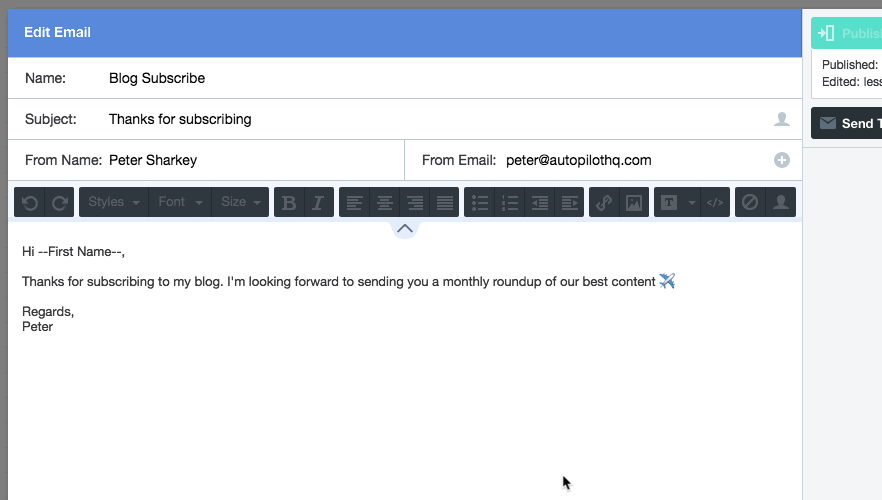
Lead nurture touchpoints—a medium personalization example:
An email or phone call nurture campaign using a call script that can be slightly adapted for each lead with a few customization fields. For example, 90 to 95% of the script could remain the same, but you’d customize the message based on the lead’s name, company name, and product or service that they’d indicated interest in.
Sounds a little cumbersome to do, but a good outbound contact center solution can make this easy for you by storing the scripts you want to use so that the whole team is using consistent messaging when reaching out to leads:
Lead nurture touchpoints—an high personalization example:
A follow-up phone or video call that’s fully tailored to each lead based on information they’ve provided you in the past (either through past conversations, contact form submissions on your website, or social media messages), which you’ve collected in your CRM.
Here’s an example in Agile CRM, which integrates with phone systems like RingCentral to let you make and receive calls with leads from your computer while showing you their profile details on the screen:
Start building and customizing your lead nurturing strategy
Remember, your leads are all at different stages in the customer journey. Don’t try to hit them all with the same message and expect it to be successful!
Do a little digging and map out the rough stages that your leads fall under, and create a set of content and outreach campaigns for each one. It might take a little more time in the beginning, but it’ll warm your leads up better—and your sales reps will thank you later on.
1marketo.com/ebooks/website-and-seo-for-lead-generation
Originally published Aug 01, 2020, updated Jun 07, 2024


